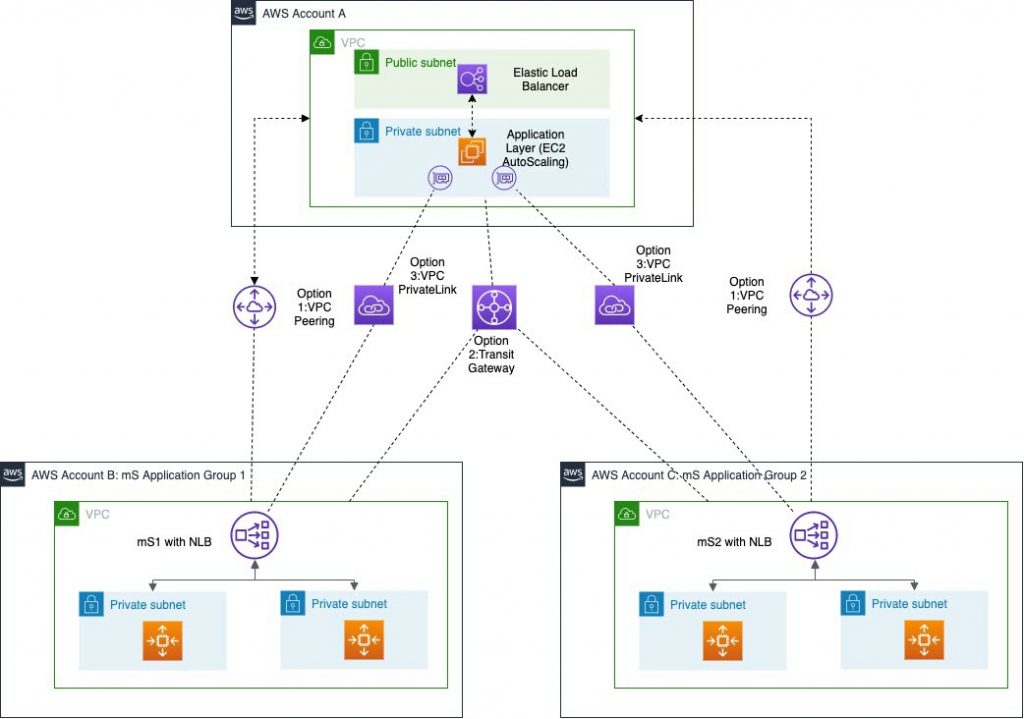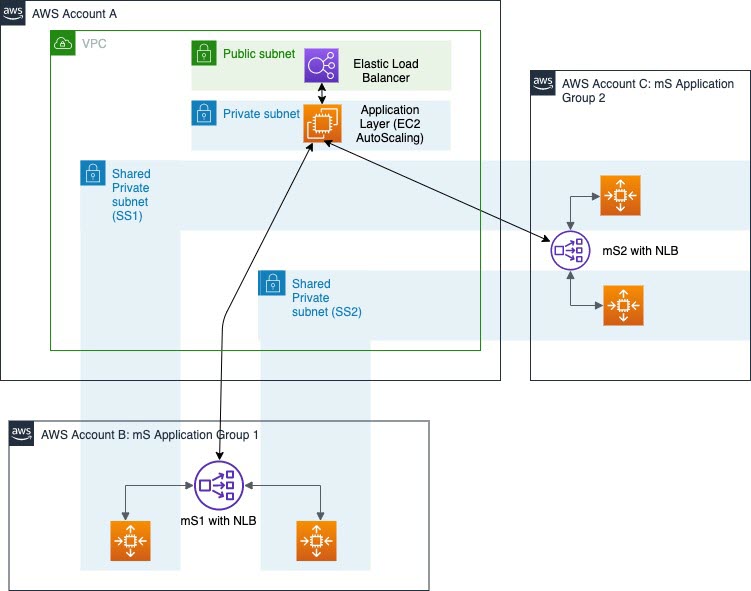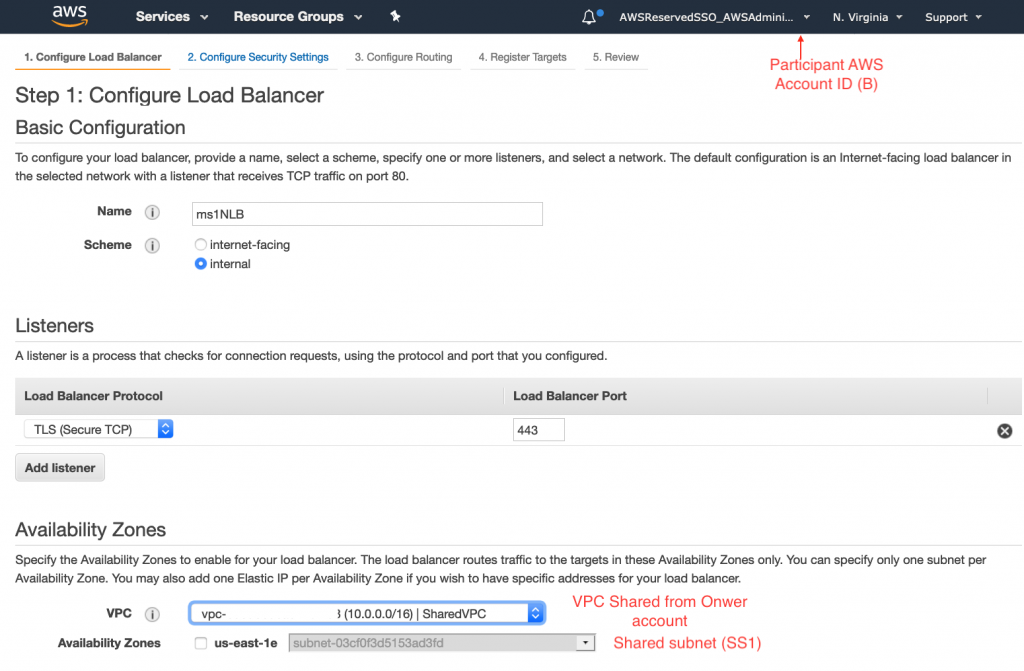AWS Architecture Blog
Using VPC Sharing for a Cost-Effective Multi-Account Microservice Architecture
Introduction
Many cloud-native organizations building modern applications have adopted a microservice architecture because of its flexibility, performance, and scalability. Even customers with legacy and monolithic application stacks are embarking on an application modernization journey and opting for this type of architecture. A microservice architecture allows applications to be composed of several loosely coupled discreet services that are independently deployable, scalable, and maintainable. These applications can comprise a large number of microservices, which often span multiple business units within an organization. These customers typically have a multi-account AWS environment with each AWS account belonging to an individual business unit. Their microservice implementations reside in the Virtual Public Clouds (VPCs) of their respective AWS accounts. You can set up multi-account AWS environment incorporating best practices using AWS Landing Zone or AWS Control Tower.
This type of multi-account, multi-VPC architecture provides a good boundary and isolation for individual microservices and achieves a highly available, scalable, and secure architecture. However, for microservices that require a high degree of interconnectivity and are within the same trust boundaries, you can use other AWS capabilities to optimize cost and network management complexity.
This blog presents a cost-effective approach that requires less VPC management while still using separate accounts for billing and access control. This approach does not sacrifice scalability, high availability, fault tolerance, and security. To achieve a similar microservice architecture, you can share a VPC across AWS accounts using AWS Resource Access Manager (AWS RAM) and Network Load Balancer (NLB) support in a shared Amazon Virtual Private Cloud (VPC). This allows multiple microservices to coexist in the same VPC, even though they are developed by different business units.
Microservices architecture in a multi-VPC approach
In this architecture, microservices deployed across multiple VPCs use privately exposed endpoints for better security posture instead of going over the internet. This requires the customers to enable inter-VPC communication using the various networking capabilities of AWS as shown below:

In the above reference architecture, we created a VPC in Account A, which is hosting the front end of the application across a fleet of Amazon Elastic Compute Cloud (Amazon EC2) instances using an AWS Auto Scaling group. For simplicity, we’ve illustrated a single public and private subnet for the application front end. In reality, this spans across multiple subnets across multiple Availability Zones (AZ) to support a highly available and fault-tolerant configuration.
To ensure security, the application must communicate privately to microservices mS1 and mS2 deployed in VPC of Account B and Account C respectively. For high availability, these microservices are also implemented using a fleet of Amazon EC2 instances with the Auto Scaling group spanning across multiple subnets/availability zones. For high-performance load balancing, they are fronted by a Network Load Balancer.
While this architecture shows an implementation using Amazon EC2, it can also use containerized services deployed using Amazon Elastic Container Service (Amazon ECS) or Amazon Elastic Kubernetes Service (Amazon EKS). These microservices may have interdependencies and invoke each other’s’ APIs for servicing the requests of the application layer. This application to mS and mS to mS communication can be achieved using following possible connectivity options:
When only few VPC interconnections are required, Amazon VPC peering and AWS PrivateLink may be a viable option. For higher number of VPC interconnections, we recommend AWS Transit Gateway for better manageability of connections and routing through a centralized resource. However, based on the amount of traffic this can introduce significant costs to your architecture.
Alternative approach to microservice architecture using Network Load Balancers in a shared VPC

The above architecture pattern allows your individual microservice teams to continue to own their AWS resources that host their microservice implementation. But they can deploy them in a shared VPC owned by the central account, eliminating the need for inter-VPC network connections. You can share Amazon VPCs to use the implicit routing within a VPC for applications that require a high degree of interconnectivity and are within the same trust boundaries.
This architecture uses AWS RAM, which allows you to share the VPC Subnets from AWS Account A to participating AWS accounts within your AWS organization. When the subnets are shared, participant AWS accounts (Account B and Account C) can see the shared subnets in their own environment. They can then deploy their Amazon EC2 instances in those subnets. This is depicted in the diagram where the visibility of the shared subnets (SS1 and SS2) is extended to the participating accounts (Account B and Account C).
You can also deploy the NLB in these shared subnets. Then, each participant account owns all the AWS resources for their microservice stack, but it’s deployed in the VPC of Account A.
This allows your individual microservice teams to maintain control over load balancer configurations and Auto Scaling policies based for their specific microservices’ needs. At the same time, using the AWS RAM they are able to effectively use the existing VPC environment of Account A.
This architecture presents several benefits over the multi-VPC architecture discussed earlier:
- You can deploy the entire application, including the individual microservices, into a single shared VPC. This is while still allowing individual microservice teams control over their AWS resources deployed in that VPC.
- Since the entire architecture now resides in a single VPC, it doesn’t require other networking connectivity features. It can rely on intra-VPC traffic for communication between the application (API) layer and microservices.
- This leads to reduction in cost of the architecture. While the AWS RAM functionality is free of charge, this also reduces the data transfer and per-connection costs incurred by other options such as VPC peering, AWS PrivateLink, and AWS Transit Gateway.
- This maintains the isolation across the individual microservices and the application layer. Participants can’t view, modify, or delete resources that belong to others or the VPC owner.
- This also leads to effective utilization of your VPC CIDR block resources.
- Since multiple subnets belonging to different Availability Zones are shared, the application and individual mS continues to take advantage of scalability, availability, and fault tolerance.
The following illustration shows how you can configure AWS RAM to set up the VPC subnet resource shares between owner Account A and participating Account B. The example below shows the sharing of private subnet SS1 using this method:
(Click for larger image)
Once this subnet is shared, the participating Account B can launch its Network Load Balancer of its microservice ms1 in the shared VPC subnet as shown below:

While this architecture has many advantages, there are important considerations:
- This style of architecture is suitable when you are certain that the number of microservices is small enough to coexist in a single VPC without depleting the CIDR block of the shared subnets of the VPC.
- If the traffic between these microservices is in-significant, then the cost benefit of this architecture over other options may not be substantial. This is due to the effect of traffic flow on data transfer cost.
Conclusion
AWS Cloud provides several options to build a microservices architecture. It is important to look at the characteristics of your application to determine which architectural choices top opt for. The AWS RAM and the ability to deploy AWS resources (including Network Load Balancers in shared VPC) helps you eliminate inter-VPC traffic and associated networking costs. And this without sacrificing high availability, scalability, fault tolerance, and security for your application.
